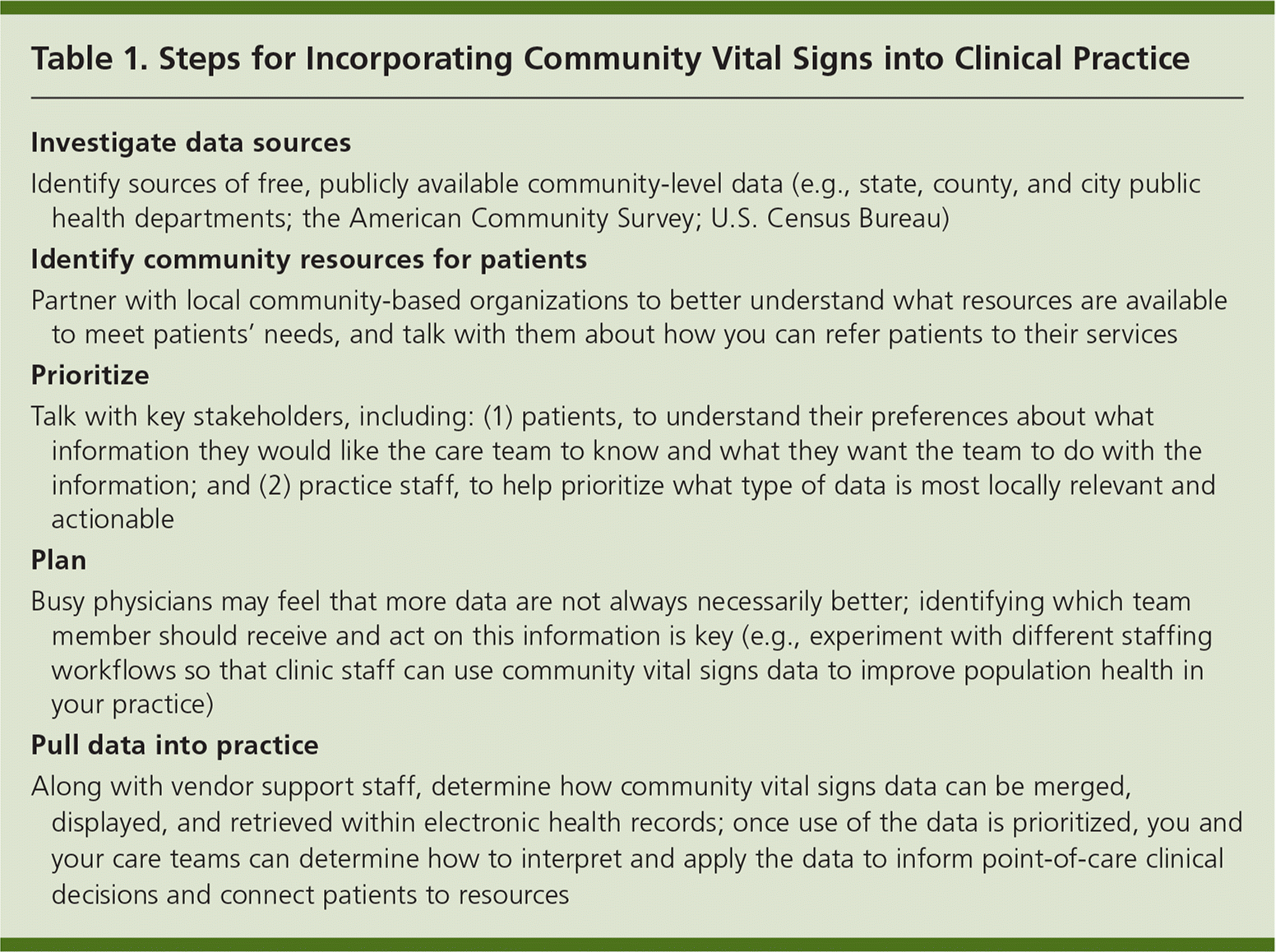
Am Fam Physician. 2017;95(11):695-696
Author disclosure: No relevant financial affiliations.
Family medicine incorporates the fundamental understanding that patient health is markedly affected by community factors—environmental quality, income and educational level, housing availability, neighborhood safety, and social connectedness.1 There is growing consensus that it is important to screen for social determinants of health in primary care and generate usable, actionable data to help physicians and practices build connections to community health resources.2,3
Individual-level data, including medical, social, and family history, are collected directly from the patient. Community-level data are acquired from public data sources such as census reports, disease surveillance, and vital statistics records. When geocoded and linked to individual data, community-level data are called community vital signs.4 Community vital signs convey patients' neighborhood health risks, such as crime rates, lack of walkability, and presence of environmental toxins. By knowing about these conditions and how they affect patients, family physicians can better understand the health risks and benefits associated with living in a particular place.
How are community vital signs used in patient care? It is now possible to merge neighborhood contextual data with individual electronic health record data to provide a more complete understanding of patients' health status. This enhanced knowledge about where patients live, learn, work, and play can help physicians tailor recommendations and target clinical services to maximize their impact. Rather than simply recommending that a patient eat better and exercise more, care teams can connect patients to a local community garden, low-cost exercise resources (e.g., YMCA), or neighborhood walking groups. As another example, knowing that a patient lives in a neighborhood with old housing may prompt a physician to proactively screen for lead exposure based on elevated community risk. Applying community vital signs in clinical practice does not have to be physician-dependent; this practice can be integrated into the workflows of community health workers, social workers, and nurse care coordinators.5,6
One model of community vital signs in action is the HealtheRx project, a community services e-prescribing initiative at the University of Chicago that is offered to residents of the city's South Side neighborhoods. After each visit at a participating clinic, patients receive a customized map of local health and social resources, individually tailored to a patient's address and diagnoses, and generated from within the electronic health record. Community resource recommendations are pulled from a database that includes housing and transportation, mental health, fitness and nutrition, and substance abuse counseling services. During the first three years of the program, more than 250,000 community resource prescriptions were generated for more than 113,000 persons receiving health care in 33 sites across Chicago. An early study of the project's implementation found that 19% of these patients accessed a service they learned about from HealtheRx; outcomes data are not yet available.7
The Practical Playbook, which is available as an online resource (https://www.practicalplaybook.org/), provides a framework for planning projects to improve population health through the lens of primary care and public health partnerships. Table 1 describes five steps family physicians can follow to incorporate community vital signs into clinical practice: investigating data sources, identifying community resources for patients,8,9 prioritizing, planning, and pulling data into practice. By following these steps, family physicians can explore how community vital signs can enhance their understanding of and clinical recommendations for patients.

| Investigate data sources |
| Identify sources of free, publicly available community-level data (e.g., state, county, and city public health departments; the American Community Survey; U.S. Census Bureau) |
| Identify community resources for patients |
| Partner with local community-based organizations to better understand what resources are available to meet patients' needs, and talk with them about how you can refer patients to their services |
| Prioritize |
| Talk with key stakeholders, including: (1) patients, to understand their preferences about what information they would like the care team to know and what they want the team to do with the information; and (2) practice staff, to help prioritize what type of data is most locally relevant and actionable |
| Plan |
| Busy physicians may feel that more data are not always necessarily better; identifying which team member should receive and act on this information is key (e.g., experiment with different staffing workflows so that clinic staff can use community vital signs data to improve population health in your practice) |
| Pull data into practice |
| Along with vendor support staff, determine how community vital signs data can be merged, displayed, and retrieved within electronic health records; once use of the data is prioritized, you and your care teams can determine how to interpret and apply the data to inform point-of-care clinical decisions and connect patients to resources |
